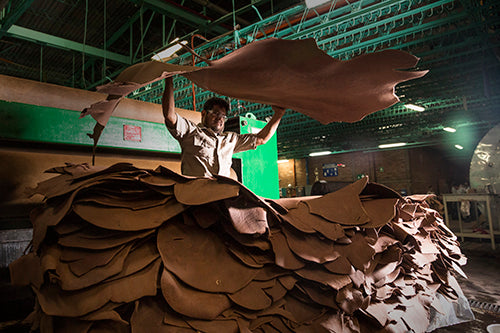The Tanning Process
ChahinLeather® has been producing full grain, vegetable tanned leather for over 85 years. The artisanal tanning process is what makes vegetable leather much different from leathers produced using other types of tannages. ChahinLeather’s® slow and time-honored vegetable tanning process sets them apart.
Preparing for Tanning
ChahinLeather® first receives Jumbo Heavy Native Steer hides from North America. These bovine hides are a byproduct of the meat industry. The hides arrive specially treated with chemical substances that prevent hides from decaying during transport or while waiting to be tanned.
The hides are first saturated with water and various soaking chemicals in large drums. After the hides have been rehydrated in these drums, they are ready for the hair to be removed in a process called liming. The dehairing operation is completed using alkaline products. The next step after liming is fleshing and splitting the hides. In this process, the hides are passed through various machines in order to get a more uniform thickness.
The hides are then placed in large drums again for deliming, which is a chemical neutralization process that makes the hides receptive to the tanning agents. All processes performed up until this point are preparation for tanning.



Vegetable Tanning
Now that the hides have been prepared, they are ready to begin the vegetable tanning process. This process is called vegetable tanning because the extracts used to tan the leather come from trees that are rich in tannins, the same substance that is found in wines and some vegetables. The vegetable tanning industry uses the tannins extracted from trees with a high concentration of tannins such as quebracho, chestnut, mimosa and acacia trees.
The hides are immersed in deep pits with these vegetable tannins and extracts and will remain there for approximately 30 days. Tanning the leather for a long period of time allows the tannins to penetrate slowly into the leather, giving the leather an unbeatable richness. During this time, the tannins are monitored and tested in the lab to ensure quality and consistency. After the hides have spent 30 days in the pits filled with the tanning liquors, they are tanned and have been transformed from hides to leather.








Oiling
Some of the leather is then dyed in large drums and then oiled. The oiling process makes the leather flexible and soft. There are different ways leather can be oiled and the method used depends on the type of leather you want to produce. The tannery’s latigo, harness, and bridle leathers are oiled in drums using very hot air along with tallows and waxes that have previously been melted. This is also called hot stuffing. This process makes the leather products weather resistant and will feature a smooth, rich cut.
The next step is the setting out process where the sides are passed through a machine to smooth the wrinkles of the leather. After this process, wrinkles may be noticed but you should not feel them since the side is flattened. The excess liquid is then removed from the sides using a samming machine. After this is complete, each piece is stretched out and cleaned by hand. This gives a unique touch to each piece.


Drying and Finishing
The leather is then sent to the drying chambers where humidity and temperature are controlled to allow the leather to dry slowly. The slow and controlled drying process is very important to ensure the quality of vegetable tanned leather.
Some leathers may require a final finish depending on the look desired and the use of the leather products that will be made using the leather. ChahinLeather® has different machines that help make a wide variety of finishes available. After the finishing is complete, the leather is ready to be used to make leather goods that can last a lifetime.



